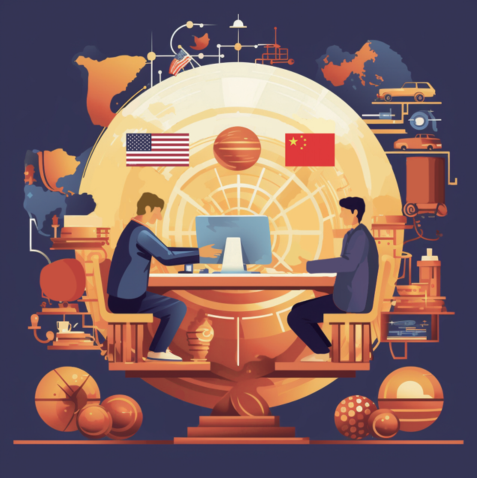Battling US' fears

WANG XIAOYING/CHINA DAILY
In response to increased sanctions from the US, China must enhance its 'countermeasure toolkit', expedite WTO reform and refine its compliance systems
For quite some time now, the United States has used the development of new technologies to remain a superpower, continuing its hegemony by imposing strict controls on exports of technology and regulating high-tech enterprises.
After World War II, Japan's technology policies accelerated its industrial catch-up, causing concern in the US and giving rise to the "Japan threat theory". The rivalry was particularly evident in the semiconductor sector, marked by fierce competition and strategic maneuvering. However, Japan's limited domestic market space determined that Japan must rely on the US market. This suppressed in the competition and it ultimately failed to shake the US' technological hegemonic position.
Currently, as China continues to raise its competitiveness in the technology industry, the US has identified the country as a strategic competitor and adjusted its technology policies toward China.
The US is attempting to contain China through international cooperation in the field of science and technology. It has resorted to various irrational actions, such as imposing tariffs on Chinese products exported to the US, and sparking trade frictions that have escalated into a technological competition. Its explicit goal is to obstruct China's technological development and buy time to ensure its own technological leadership.
As one of the initial governmental agreements established between China and the US following the establishment of diplomatic relations, the "Agreement between the Government of the United States of America and the Government of the People's Republic of China on Cooperation in Science and Technology" has long been regarded as a significant symbol of technological collaboration between the two nations. This agreement expired on Aug 27. However, due to growing concerns within the US government regarding China's increasing military capabilities and other factors, instead of renewing the agreement for another five years, the US opted to extend it for an additional six months, primarily driven by domestic pressures, to create room for negotiations with China on the terms of the agreement.
In comparison with previous technological disputes between the United States and Japan, the current US technology blockade against China is fundamentally different. The US employed traditional economic sanctions against Japan, such as imposing tariffs and restricting exports. The US is adopting not only economic sanctions against China, but also technological decoupling and stigmatization tactics. It has also established initiatives such as the Semiconductors in America Coalition and the Chip 4 Alliance, actively shaping a semiconductor supply chain system aimed at reducing reliance on China.
By reviewing and comparing the technological disputes between China and the US as well as between the US and Japan, we can draw some insights and strategies for addressing them.
First, the current technological conflict between China and the US differs fundamentally from the past US-Japan technological dispute. China is accelerating the development of a unified national market and gradually establishing a dual-circulation new development paradigm that can coordinate both domestic and international markets. Therefore, China does not need to rely on the US market, which means the US cannot defeat China in the same way as it did to Japan.
Second, the US has adopted suppressive and restrictive measures against China's technology industry and enterprises. In the short term, the US aims to maintain its technological and economic advantage by implementing a technological "decoupling" from China. However, it disregards that by doing so the US economy will suffer greatly, and certain crucial industries will incur substantial losses. In the long run, the US is trying to decouple the global supply chains that require the support of Chinese manufacturing.
Last, the US perceives China's economic development, technological advancements, and industrial upgrades as challenges to its inherent advantages, and it is concerned about the potential erosion of its global technological leadership in the 21st century.
The future of US-China relations largely hinges on the rational judgment of the US. Unfortunately, the US government not only persists in its technology containment measures but also continues to obstruct China's development endeavors. As China accelerates its journey toward becoming a technological powerhouse, the competition between the two nations will undoubtedly persist. The trajectory of US-China relations in the future depends not only on the rational judgment of the US, but also on the wisdom of China's response.
First and foremost, in response to increased sanctions by the US, the Chinese government must continuously enhance its "countermeasure toolkit" and promptly introduce corresponding supporting systems. Since the Joe Biden administration took office, the US has initiated large-scale sanctions against China multiple times, evolving from targeted sanctions based on single specific reasons to mixed sanctions based on various grounds. China's response strategy not only needs to be adjusted in line with the changes in the US technology policies, but also should focus on undermining the US' schemes. In recent years, the Chinese government has enacted a series of countermeasure laws and regulations, forming an export control system characterized by "scientific design, orderly operation, and effective enforcement".
These laws and regulations provide robust legal support and protection for China to lawfully counter foreign discriminatory measures. However, it is still necessary to establish relevant supporting systems to address specific enforcement issues. This includes the development and issuance of regulations, rules, implementation details, compliance guidelines, and other documents in the field of countermeasures.
Second, the reform of the World Trade Organization needs to be expedited to leverage the coupling effects between the global trade governance system and the global technology governance system. The technology domain has always been a challenging aspect of global governance. Contemporary global technology governance primarily encompasses major issues such as the governance of global technological challenges, the risk management of technological development, and the regulatory governance of technological innovations. Many of these issues intersect with global trade governance topics. By driving changes in the global trade system, allowing the WTO to better fulfill its roles in negotiation, monitoring and dispute resolution, and subsequently facilitating the development of a more comprehensive global technology governance system, this could promote a favorable evolution in US-China technology relations.
Last, Chinese enterprises need to establish and gradually improve their compliance systems as soon as possible to enhance their compliance operational capabilities in the process of internationalization. Chinese science and technology companies must fully realize that regulation plays a significant role in driving their scientific and technological innovation. They should actively cooperate with national regulatory efforts and leverage the development of a unified national market to make full use of both domestic and international markets and resources to enhance their international competitiveness. Relevant departments should promptly summarize domestic and foreign experiences and practices in compliance, and help enterprises improve their "compliance systems" in the form of warning cases and best practices to help them enhance their compliance operational capabilities.
The author is a professor at the School of Economics and Finance and the Center for Regional Economic Cooperation Studies at Shanghai International Studies University.
Photos
Related Stories
- U.S. House Speaker McCarthy faces challenge as government shutdown looms
- Chinese vice president meets Guterres, Blinken on sidelines of UNGA session
- "Long way to go" before agreements reached to end strike in Detroit, says union chief
- U.S. homebuilder sentiment turns negative for first time in five months
- US 'black hole' in global anti-drug efforts: China
- Unscrupulous cyber spying sheds light on U.S. hegemonic paranoia
Copyright © 2023 People's Daily Online. All Rights Reserved.









